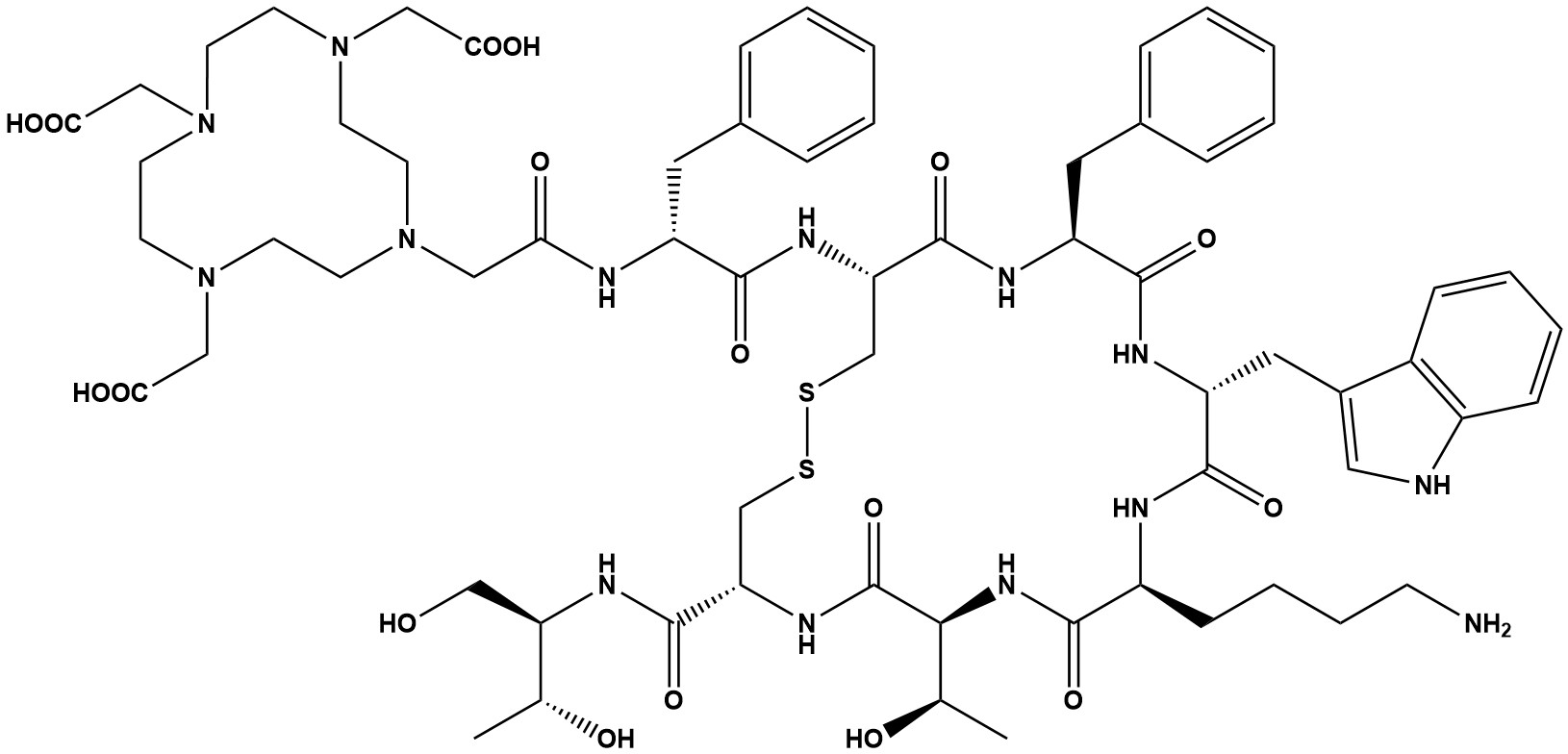| Synonym: | DOTA-D-Phe-Cys-Phe-D-Trp-Lys-Thr-Cys-Threoninol (Disulfide bridge: Cys2-Cys7) |
| CAS #: | 209277-09-8 (net) |
| Molecular Formula: | C65H92N14O17S2 |
| Molecular Weight: | 1405.7 |
| DOTA-Octreotide is not a single drug in the traditional sense, but a powerful radiopharmaceutical conjugate used in the diagnosis and treatment of specific types of cancer, primarily neuroendocrine tumors (NETs). It is a prime example of “theranostics,” a field of medicine that combines a diagnostic approach (imaging) with a targeted therapeutic approach (therapy) using a single molecular platform. 1. What is DOTA-Octreotide? DOTA-Octreotide is a chemical compound consisting of two main parts: • Octreotide: This is the “targeting” component. It is a synthetic analog of the naturally occurring hormone somatostatin. Somatostatin, and by extension octreotide, has a high affinity for somatostatin receptors (SSTRs), especially subtype 2 (SSTR2). Many neuroendocrine tumors overexpress these receptors on their cell surfaces, making them a perfect target for diagnosis and treatment. • DOTA (1,4,7,10-tetraazacyclododecane-1,4,7,10-tetraacetic acid): This is a “chelating” component. DOTA is a molecule that acts like a claw, securely holding onto a metal ion (a radionuclide). This is a crucial part of the compound’s design, as it prevents the radioactive metal from detaching and causing radiation damage to unintended tissues. When you combine the targeting function of octreotide with the chelating function of DOTA, you get DOTA-Octreotide. This molecule is then “labeled” with a specific radionuclide depending on its intended use. The most common radionuclides used are: • 68Ga (Gallium-68) • 177Lu (Lutetium-177) • 90Y (Yttrium-90) 2. Mechanism of Action: The Theranostic Approach The brilliance of DOTA-Octreotide lies in its ability to deliver a payload directly to cancer cells. The process can be summarized as follows: 2.1 Targeted Binding The DOTA-Octreotide molecule is administered intravenously. It circulates in the body and, due to the high expression of SSTR2 on NET cells, it preferentially binds to the surface of these tumor cells. 2.2 Internalization Once bound, the receptor-ligand complex is internalized by the cell through a process called endocytosis. This pulls the DOTA-Octreotide and its attached radionuclide inside the cancer cell. 2.3 Payload Delivery The radionuclide now resides within the tumor cell. The type of radionuclide determines the next step: • Diagnostic Imaging (68Ga-DOTATATE): Gallium-68 is a positron emitter. When it decays, it emits a positron which, upon annihilation with an electron, produces two photons that are detected by a Positron Emission Tomography (PET) scanner. This creates a detailed, high-resolution image of the tumor and its metastases throughout the body, helping physicians stage the disease and plan treatment. This diagnostic use is often referred to as a “DOTATATE scan” or “Gallium scan.” • Therapeutic Radiation (177Lu-DOTATATE and 90Y-DOTATOC): Lutetium-177 and Yttrium-90 are beta-particle emitters. Beta particles are high-energy electrons with a short range (typically less than 2-3 mm) in tissue. Once the labeled DOTA-Octreotide is internalized, the radionuclide releases these beta particles, which cause DNA damage and cell death specifically within the tumor cell and its immediate neighbors. This is a highly localized form of radiation therapy that spares surrounding healthy tissue. This dual-use capability is what makes DOTA-Octreotide so effective. A diagnostic scan with 68Ga-DOTATATE can confirm if a patient is a suitable candidate for therapy with 177Lu-DOTATATE. If the tumor lights up on the PET scan, it means the somatostatin receptors are present, and the therapy will be effective. 3. Clinical Applications DOTA-Octreotide and its variants have become a standard of care for patients with well-differentiated, somatostatin receptor-positive neuroendocrine tumors. • Diagnostic Staging: 68Ga-DOTATATE PET/CT is a superior imaging method compared to older techniques like 111In-DTPA-octreotide scintigraphy. It provides a more accurate and sensitive assessment of tumor location and extent, which is crucial for determining the best course of action. • Peptide Receptor Radionuclide Therapy (PRRT): 177Lu-DOTATATE (marketed as Lutathera) has been a game-changer for patients with unresectable or metastatic gastroenteropancreatic neuroendocrine tumors (GEP-NETs). Clinical trials like the NETTER-1 and NETTER-2 studies have demonstrated significant improvements in progression-free survival and overall response rates compared to standard somatostatin analog therapy alone. 4. Comparison to Traditional Therapies Before the advent of DOTA-Octreotide PRRT, treatment options for advanced NETs were more limited. Traditional somatostatin analogs like Octreotide (unlabeled) were used to control symptoms and slow tumor growth, but their anti-proliferative effect was modest. DOTA-Octreotide PRRT offers a significant advantage by directly targeting and killing tumor cells. Recent clinical trials have shown a dramatic increase in progression-free survival for patients receiving PRRT in combination with standard therapy, establishing it as a new standard of care. DOTA-Octreotide is a revolutionary compound that exemplifies the power of theranostics. By linking a specific targeting agent to a radionuclide, it enables both precise diagnostic imaging and highly effective, targeted radiation therapy. Its role in the management of neuroendocrine tumors has profoundly changed the treatment landscape, offering new hope and improved outcomes for patients with these challenging cancers. The continued development of similar radiopharmaceuticals holds great promise for the future of personalized cancer medicine. References 1. 68Ga-DOTA-Tyr3-Octreotide PET in Neuroendocrine Tumors: Comparison with Somatostatin Receptor Scintigraphy and CT 2. DOTA-Derivatives of Octreotide Dicarba-Analogs with High Affinity for Somatostatin sst2,5 Receptors 3. Utility of 68Ga DOTA-Octreotate PET/CT in Characterization of Pediatric Neuroendocrine Tumors 4. Neuroendocrine Tumor Imaging With 68Ga-DOTA-NOC: Physiologic and Benign Variants |
|
DOTA-Octreotide
For Research & Development use only. Not for testing and/or use on humans.



